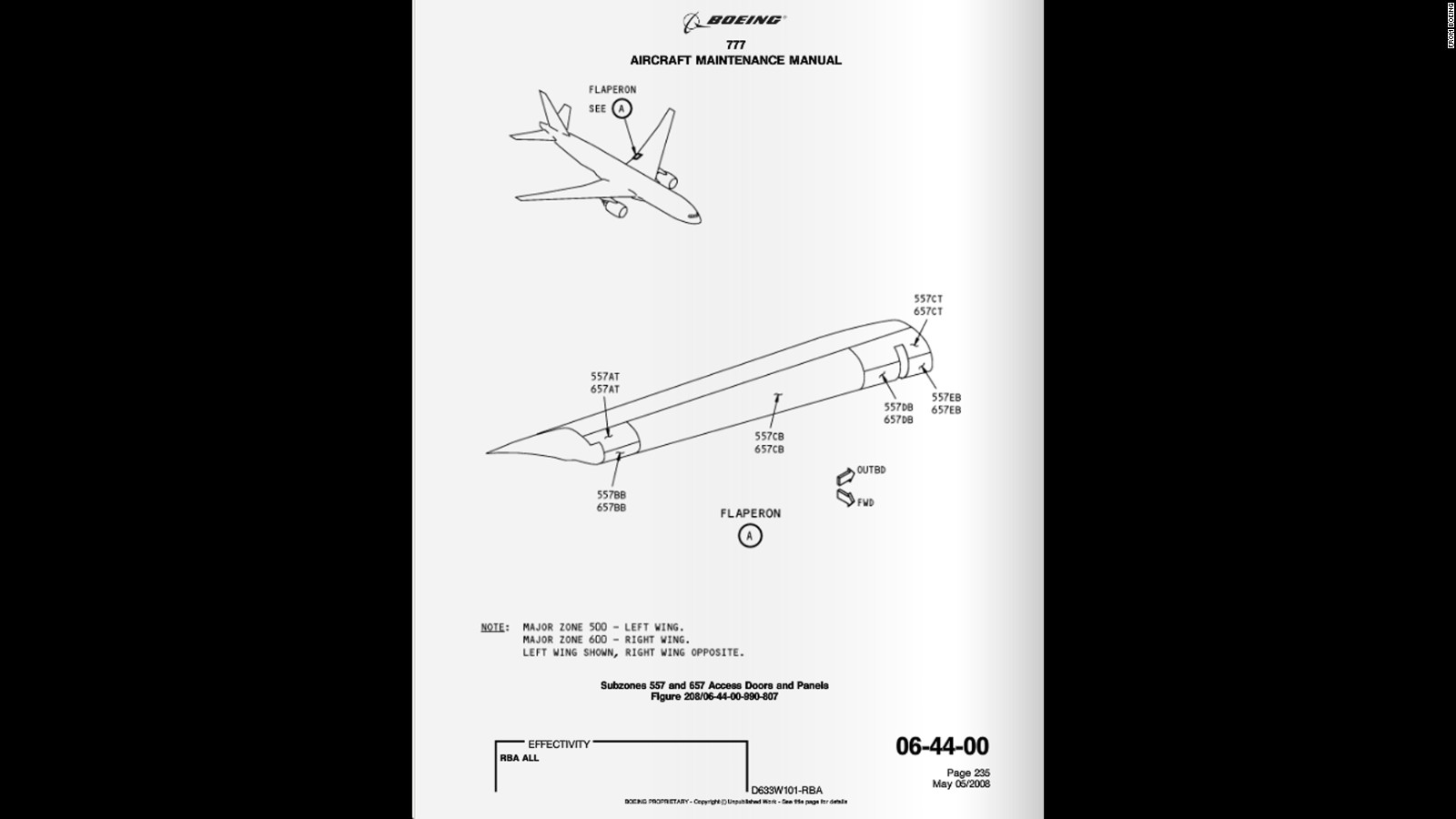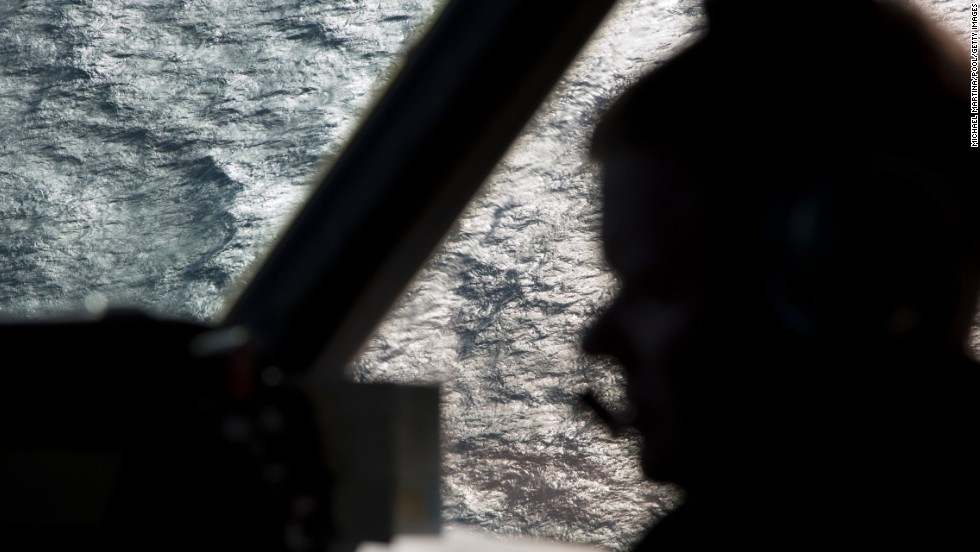One group of independent observers said Thursday that the damage to the component -- a right wing flaperon -- should give authorities a good indication that the piece came off while the plane was still in the air.
The group, led by American Mobile Satellite Corp. co-founder Mike Exner, points to the small amount of damage to the front of the flaperon and the ragged horizontal tear across the back.
The rear damage could have been caused if the airliner had its flaperon down as it went into the ocean, some members of Exner's group wrote in a preliminary assessment after looking at photos and videos of the component.
But the lack of damage to the front makes it more likely the plane was in a high-speed, steep, spiral descent and the part fluttered until it broke off, the group said.
Boeing and Australian officials are confident the debris -- found Wednesday off the coast of a remote island in the west Indian Ocean -- came from a Boeing 777 -- and might be from Malaysia Airlines Flight 370, a 777 that disappeared in March 2014 with 239 people on board.
The plane debris will be transported to France on Friday evening, a spokeswoman for the Paris prosecutor's office said. Agnes Thibault-Lecuivre said the piece will arrive in Paris on Saturday and will be sent to Toulouse, the site of the nearest office of
the BEA, the French authority responsible for civil aviation accident investigations.
Exner's group -- an informal cadre of aviation experts -- said that if the flaperon were still on the wing when the plane hit water, the front would have been damaged by hitting the part of the wing to which it was attached. And the rear damage looks like it was caused by stress rather than being bent and broken off when the plane hit the water.
But an aircraft component specialist who spoke to CNN disagreed.
The lack of damage to the front section "tells me that the component could still have likely been back in its original position inside the wing itself," said Michael Kenney, senior vice president of Universal Asset Management, which provides plane components to airlines.
'Highly confident' component from Boeing 777
Boeing investigators are confident that debris found on a remote island in the Indian Ocean comes from a 777 aircraft, according to a source close to the investigation.
Martin Dolan, chief commissioner of the Australian Transport Safety Bureau, agreed.
"We are highly confident but it still needs confirmation that it is a part from a 777 aircraft," he told CNN's "Erin Burnett OutFront." "The only 777 aircraft that we're aware of in the Indian Ocean that could have led to this part floating is MH370. But as I said, we still need to confirm that through closer study."

EXPAND IMAGE
People cleaning a beach found the debris Wednesday on Reunion, a French overseas territory in the western Indian Ocean.
The source said Boeing investigators feel confident the piece comes from a 777 because of photos that have been analyzed and a stenciled number that corresponds to a 777 component. A component number is not the same as a part number, which is generally much longer.
Images of the debris also appear to match schematic drawings for the right wing flaperon from a Boeing 777. A flaperon helps the pilot control the aircraft. It is lightweight and has sealed chambers, making it buoyant.
Despite this confidence, no one is saying the part definitely comes from a 777, much less MH370.
Finding the debris is a "significant development" in the search for MH370, Australian Deputy Prime Minister Warren Truss said.
More debris
New debris, which washed ashore Thursday and appears to resemble remnants of a suitcase, is also part of the investigation, Reunion Island police officials confirmed to CNN.
The flight vanished March 8, 2014, en route to Beijing. So far, no confirmed trace of it has been found, making it one of history's biggest aviation mysteries and leaving relatives of passengers and crew members
uncertain about the fate of their loved ones.
A preliminary assessment by U.S. intelligence agencies, produced in the wake of the MH370 disaster, suggested it was likely someone in the cockpit deliberately caused the aircraft's movements before the Malaysian airliner disappeared.
Two U.S. officials briefed on the matter told CNN that the assessment, which was not intended for public release, was prepared months ago and was solely based on available satellite and other evidence.
The U.S. intelligence assessment was largely focused on the multiple course changes the aircraft made after it deviated from its scheduled Kuala Lumpur to Beijing route. Analysts determined that, absent any other evidence, it's most likely someone in the cockpit deliberately moved the aircraft to specific waypoints, crossing Indonesian territory and eventually toward the south Indian Ocean.
Malaysian investigators haven't reported finding any evidence that casts suspicion on the pilots.
The airliner's crew has been the focus of attention since the mysterious disappearance,
but no proof has emerged indicating they intended to destroy the plane. Law enforcement and intelligence agencies from numerous countries examined the plane's manifest of crew and passengers and found no significant information to suggest anyone on board posed an obvious threat.
Missing plate
If it does turn out to be from Flight 370, the development would reassure Australian officials that they are looking for the rest of the plane in the right area, Truss and Dolan said.
"It's credible that debris from MH370 could have reached the Reunion Islands by now," Truss said.
Malaysia Airlines is sending a team of investigators to Paris and a second team to Saint-Denis, Reunion, on Friday, an airline official in Kuala Lumpur, Malaysia, told CNN.
It's unclear how identification will be made.
Normally identification would be aided by a small serial number plate attached to a flaperon, but the part found on the beach appears to be missing the serial number plate, according to photographs.
Other markings may be found on the part, said Kenney, the executive from Universal Asset Management.
 Malaysian Prime Minister Najib Razak (C) attends a press conference on the missing Malaysian Airlines flight MH370 in Kuala Lumpur, Malaysia, Aug. 6, 2015. Verification had confirmed that the debris discovered on the Reunion Island belongs to the missing Malaysian Airlines flight MH370, Malaysian Prime Minister Najib Razak announced here early on Thursday. (Xinhua/Chong Voon Chung)
Malaysian Prime Minister Najib Razak (C) attends a press conference on the missing Malaysian Airlines flight MH370 in Kuala Lumpur, Malaysia, Aug. 6, 2015. Verification had confirmed that the debris discovered on the Reunion Island belongs to the missing Malaysian Airlines flight MH370, Malaysian Prime Minister Najib Razak announced here early on Thursday. (Xinhua/Chong Voon Chung)










